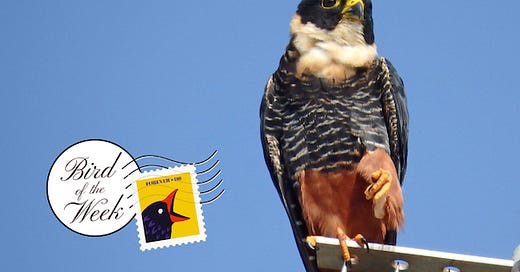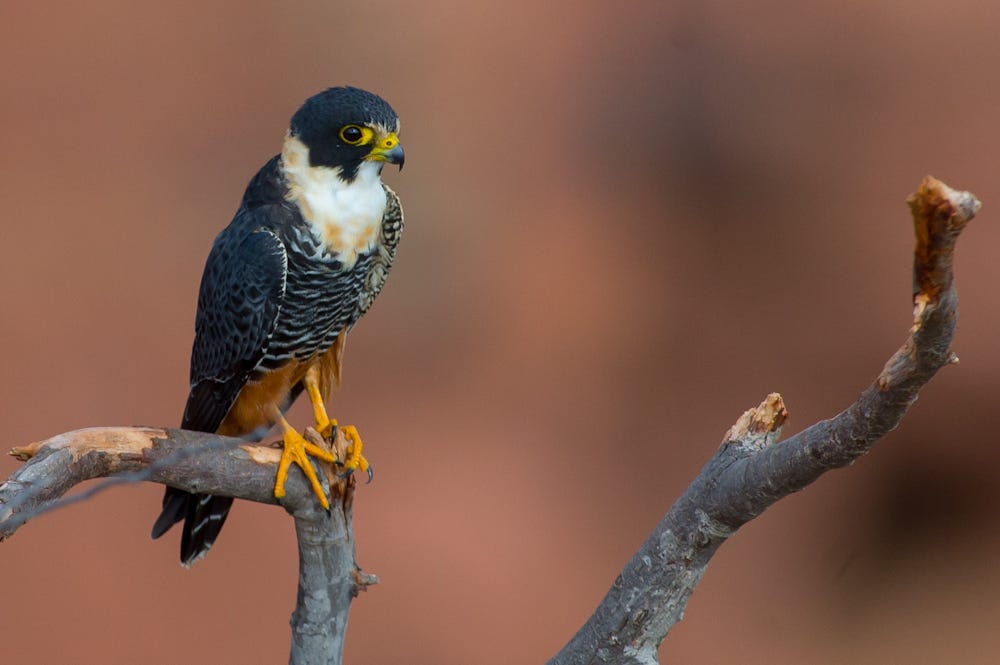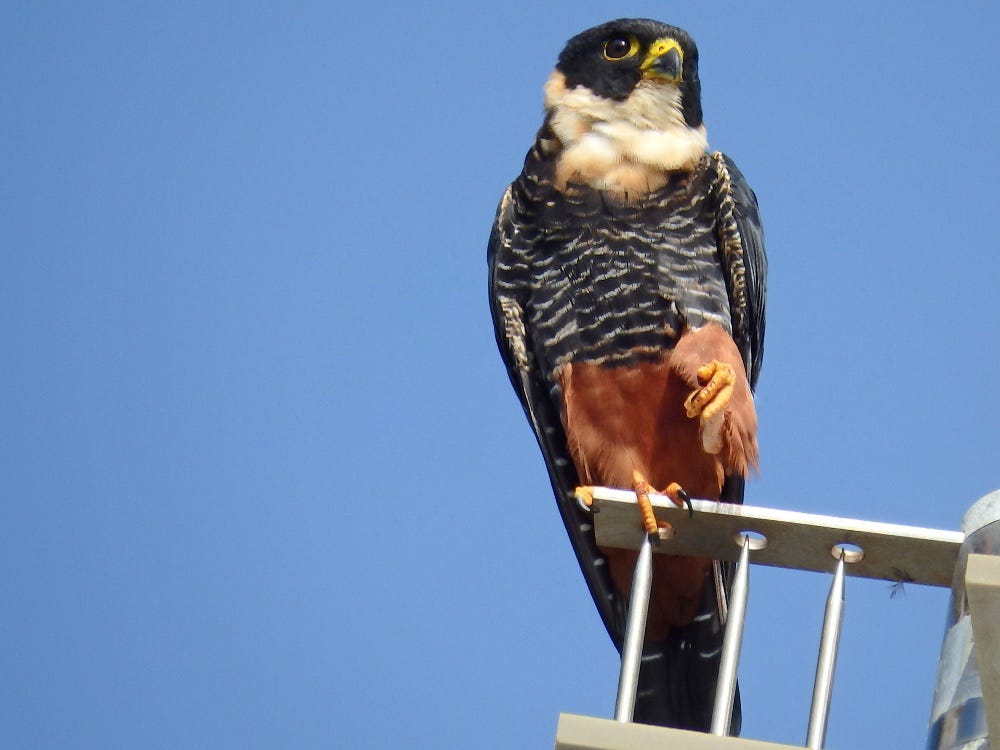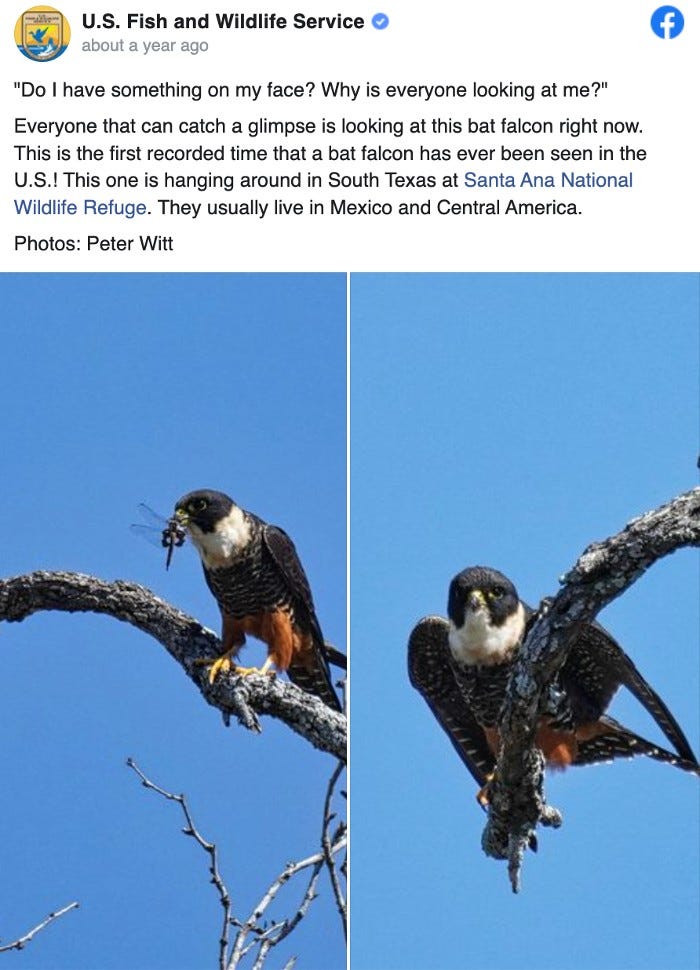
Now that we’re doing Falcon Month (our first-ever themed month!) here on Bird of the Week, I thought that the long-running problem of Which Bird Should I Choose There Are So Many Good Birds Agggghhhhhhhhhh would be somewhat alleviated. But guess what: Which Bird Should I Choose There Are So Many Good Birds Agggghhhhhhhhhh was swiftly replaced by Which Falcon Should I Choose There Are So Many Good Falcons Agggghhhhhhhhhh. Everywhere you look, a falcon is being awesome. It’s because of that that we must rely on gut instinct rather than finely-balanced reasoning to make the final calls.
I say all this to explain why my decision to choose this week’s Falcon Month pick came down to two things: “oooh name!!!” and “oooh pretty!!!” But when you see this bird, I feel confident that you will be on board, because, folks, I’m talking about….the bat falcon.
KA-BOOM. Yes, it’s called the BAT FALCON, and it looks like THAT. The black and white and yellow and slightly orange coloring? The stripes????? The way that it looks both cute enough that you go “awwwww” and also dangerous enough that you’d run a mile from it? And did I mention it is called the BAT FALCON? Humans are just out here being called regular names and birds get to be called bat falcons. The world is unfair!
Just marvelous, marvelous. The bat falcon is on the smaller side, but obviously it packs a big punch. It’s normally found all throughout Mexico, Central America (including around Mayan ruins!), and much of South America. In late 2021, though, one was spotted in the United States1 for the first time ever. This was an extremely big deal.
People love to crowd around when an interesting bird shows up in an unexpected location—when I went to see Flaco, the famous escaped Central Park owl (who is still doing well!) there were seriously like 50 people all gathered beneath his tree—so it’s no surprise that, when the bat falcon signal went up in Texas, thousands of birders dropped everything and raced to see the new visitor. Here’s one guy talking to Border Report:
Retired school teacher Ray Sharpton, 77, earlier this week drove alone for 34 hours from upstate New York to the Santa Ana National Wildlife Refuge, where he has spent the past three days hoping to spot the bat falcon.
[…]
“I first heard about the bat falcon on eBird alert,” Sharpton told Border Report. “I’ve been watching it on the computer and finally one day I said, ‘I’m going!'”
He left his home at 3 a.m. on Monday, much to the chagrin of his adult daughter, and drove non-stop in his well-worn 2009 Honda Accord, which has over 212,000 miles, most of it put on birding across the country including Alaska.
Sharpton cat-napped at rest stops and used the trunk as a “kitchen.” Aside from sore legs, he arrived safely at the wildlife refuge Tuesday but is now dealing with foot blisters from so much walking trying to spot the bird.
Ray rules, and his kid should let him do his thing. If you saw this bird in real life, you would lose your mind:
Anyway. Moving on. For you nerds out there, there is lots of talk online that the bat falcon inspired the name of the Millennium Falcon in Star Wars. Do I know this to be true? No. Also apparently someone named Quipp Fargil gave it this name. Do I know who Quipp Fargil is? Absolutely not. But there you are.
The bat falcon is called a bat falcon because guess what? It loves to eat bats. You could almost say… it goes batty for bats. According to the Nature Conservancy, the bat falcon’s crepuscular habits (meaning that it’s mostly active at dusk and dawn) make it a perfect match for bats as they travel to and from their daytime hangout spots. And here’s this interesting fact from the Nature Conservancy:
Like many birds of prey, male bat falcons are smaller than females, and so they typically take smaller prey, like insects. The larger females are more likely to kill and consume bats and birds.
We love a bird that breaks the tired old gender paradigms!
Here is a video of a bat falcon (presumably a female?) catching a bat IN MID-AIR. And it does this by tilting its claws upwards, so really it’s catching a bat in mid-air while partially bent towards the ground.
Astonishing. Apart from bats, bat falcons also eat insects, small birds, snakes, mice, frogs, and several other little critters. A very balanced diet, I think!
Two final facts: the call of the bat falcon goes “kee kee kee” (you can hear that here) and if you want to tell someone in Norway about it, say, “whoa, look at that Flaggermusfalk!”
Bat falcons are not endangered, but they are declining due to—you guessed it!—habitat loss. Wonder who is responsible for that? For the millionth time, can humanity please get its act together so that bat falcons and all the other birds and animals of the land, sea, and sky can LIVE??? Grrr.
OK, that’s all from me about the bat falcon. Falcons are so awesome!!!
Though, since Texas was part of Mexico until very recently in geological time, and birds have been around forever, could this actually count as the bird being spotted higher north in what its species still perceives to be Mexico??? Something to consider.





















You could change your name to Bat Falcon, no one can stop you